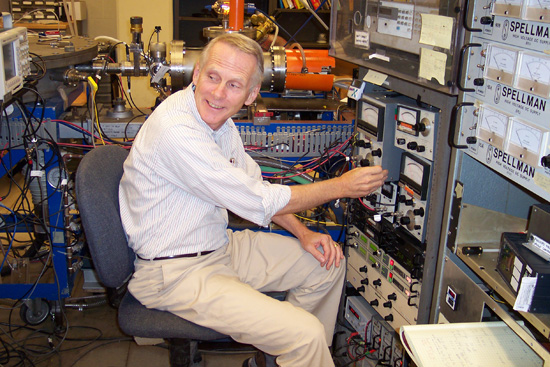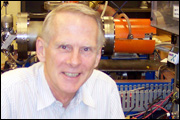Physics Professor Studies Exotic Atoms
 |
| Tom Morgan, the Foss Professor of Physics, developed a laser lab in the basement of Exley Science Center. He uses a control panel to fire atoms and study quantum mechanics. His atom research is supported by a recent National Science Foundation award of $200,000. |
| Posted 08/24/06 |
| In outer space, some protons and electrons can travel millions of years alone before colliding, forming super-excited exaggerated atoms. Tom Morgan, the Foss Professor of Physics, wants these atoms to come back down to earth.
For the past 20 years, Morgan, an atomic and molecular physicist, has experimented with these excited atoms known as Rydberg atoms. With the help of Wesleyans Scientific Support Services, hes designed and created two accelerator collision systems in the basement of Exley Science Center. By shooting a laser beam at a series of regular atoms, he can create Rydberg atoms, which escalate the electrons orbit 10,000 times further than in a regular atom. These giant atoms, with elusive properties, are ideal to study to gain insight into the connection between quantum mechanics and classical physics. What Ive always been interested in is what I learn about an atom or molecule on a fundamental level, Morgan says from his second floor office in the Exley Science Center. I want to learn about their structure, their dynamics, and how the size of an atom affects its behavior.
Morgan began his career at Wesleyan 33 years ago by studying properties of fast protons colliding with alkaline atoms magnesium, calcium, strontium and barium. In the mid-80s, he began investigating Rydberg atoms in hydrogen and helium. Recently, his research interests include molecular spectroscopy and dynamics of highly excited Rydberg states in strong electric fields and plasma environments. His most recent contributions include studying Rydberg argon dynamics and the first measurement of a scaled-energy recurrence spectrum for molecules. Morgan says he is among about a hand-full of researchers in the world studying scaled-energy laser-excited atoms in strong electric fields and the first to apply the technique to hydrogen molecules. When youre doing cutting-edge research, its not going to be easy, he says overlooking his self-designed laser-accelerator control panel. Everything has to be perfect to get the right conditions and results. Doing this type of work requires not only brains, but a lot of patience and good hands. Lutz Huwel, chair of the Physics Department and professor of physics, says Morgan’s positive and constructive attitude in the classroom stands out just as much as his love for physics. “Tom loves physics of all kind above all the Rydberg atoms and molecules he and his dedicated group of students are investigating in his lab,” Huwel says. “He is always on the lookout for interesting things to do and to talk about. He has a knack for getting students excited about physics.” In October, one of Morgan’s undergraduate students, Jack DiSciacca ’07, will be presenting his research results at a national laser science conference in Rochester, N.Y. DiSciacca is a Goldwater Scholar for the academic year 06-07 and is writing his senior honors thesis on Rydberg hydrogen molecules. Morgan, who was born and raised in Brooklyn, N.Y., says his interest in physics came about in high school, when his algebra teacher said he had quite the ability in math. I perked up at this, because this person thought I was actually good at something. That was my defining moment. It gave me the confidence to pursue math, and later physics, he says. He studied math and the sciences at Carroll College in Helena, Mont. and Montana State University, Bozeman and received his Ph.D from the University of California, Berkeley in 1971. His thesis covered the collisional formation and destruction properties of excited hydrogen molecules. In 1973, after two years at Queens University of Belfast, N. Ireland, Morgan came to Wesleyan, and began teaching general physics classes, more advanced classes for majors and graduate level courses. Morgan has published more than 85 articles in leading physics journals. Hes overseen dozens of students pursuing Ph.D degrees and senior honors theses, who often report their findings at national conferences and publish in scientific journals. Morgan, who also is Wesleyans Academic Secretary, served as the Chairman of the Physics Department for five years, and the Dean of the Sciences and Mathematics for three years. He has held several visiting research appointments at other universities, including the University of Paris, France, the University of Colorado, Boulder, the University of Mexico, Mexico City and at Dublin City University, Ireland, where as a Fulbright Senior Scholar he established a physics undergraduate student exchange program with Wesleyan. Wesleyan was great when I arrived here, and its great now, Morgan says. The teaching and research environment is wonderful and my colleagues are superb, but what I really love about Wesleyan is the students. It is the bright students in the classroom and in my lab that have kept me here all these years. He is presently a Distinguished Visiting Fellow at Queens University, Belfast, Northern Ireland, where he is collaborating on research programs devoted to plasma physics. Hes also a fellow of the American Physical Society and the Institute of Physics in the United Kingdom and Ireland. Hes also a four-time marathon runner, a big New York Yankees fan, and a singer/musician for an Irish Celtic band. Morgan is one of three in his family to work at Wesleyan. His wife, Janet, retired in 2003 from Information Technology Services, and his son, Brent Morgan, is an instructional media specialist for ITS and the Center for the Arts. But after more than three decades here, Tom has no plans to leave Wesleyan just yet. No, I cant even think about (retirement), he says, turning the knobs on his laser lab control panel. I am having too much fun.” |
| By Olivia Drake, The Wesleyan Connection editor |


 Over the years the Research Corporation, the Department of Energy, and the National Science Foundation have supported his research. On Aug. 15, the NSF awarded a grant of $200,000 for laser research equipment.
Over the years the Research Corporation, the Department of Energy, and the National Science Foundation have supported his research. On Aug. 15, the NSF awarded a grant of $200,000 for laser research equipment.